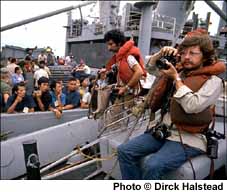
EPILOGUE
It may have been over 30 years ago, but the events of those last days in Saigon still haunt me. I don't know anyone who went through that experience who hasn't been permanently affected by it. After hopscotching from one ship in the fleet to another, I managed to make my way to Subic Bay, securing a seat on a plane, from the U.S.S. Coral Sea, to carry my film and that of my colleagues. The film arrived in New York by deadline, but Saigon was old news. Time ended up running an "art" portrait of Ho Chi Minh on the cover, and for most of its inside coverage used wire service photos. The majority of photographs accompanying this diary were never published at the time, although they did wind up winning me the Robert Capa Gold Medal that year. Several of us made a stopover in Hong Kong a few days after the fall. There, we ran into Hunter Thompson, who had left Saigon long before the evacuation. Frustrated with the inability to tell our stories in print, we poured our hearts out to him, in the hopes that he, at least, could shape them into a story. He never wrote a word.
In the fall of 1976, I took my caption envelopes and notes, and reconstructed my experiences as a screenplay. NBC bought it for a Movie of the Week, but just as we were going into pre-production Brandon Tartikoff became head of the network and the project was scrapped. This diary is gleaned largely from my original notes. In 1995, I revisited Vietnam to work on my documentary "Goodnight Saigon," (which can be viewed in streaming RealVideo). Nguyen Van Thom now owns a one-hour photo lab, a block from where I last saw him in 1975. Graham Martin, who had left the embassy in the early morning hours of April 30, carrying his dog and the American flag, returned to the U.S., roaming the halls of the State Department for several years until he retired from the foreign service. Colonel Alfred Grey, who ran the Marine evacuation, went on to become Commandant of the Marine Corps. Hillary Brown still reports from the world's trouble spots for ABC News. Roy Rowan, who shut down Time's Saigon bureau, is just back from Vietnam with a major story for Fortune Magazine. Neil Davis, the NBC correspondent who was on the rooftop with me that last day, was killed September 9th, 1985 in Bangkock covering a coup. Michel Laurent was the last photojournalist to die in Vietnam The North Vietnamese took Saigon, bulldozed the cemeteries where South Vietnamese troops were buried, and renamed the city Ho Chi Minh. Today, the old general who was the first
official named by the North Vietnamese to run the city, wanders the streets
barefoot, protesting the results of the revolution he fought so hard for--a
bizarre combination of corruption and commercialization. Skyscrapers rise
on an almost monthly basis, and American tourists clog the streets, ducking
into trendy California-style restaurants.
The F-15 fighter that led the bombing raid on the Palace that day in April 1975 now sits in a square in the center of Saigon. Its pilot, who deserted with his plane to join the North Vietnamese, is now a Senior Captain for Air Vietnam, and his daughter is a flight attendant. The one wish he has is to fly the airline's first commercial flight to the United States. Dirck Halstead
|
 Time
flew my wife, Ginny, to meet me in Hawaii. For the next week, we occupied
an idyllic and peaceful thatched-roof bungalow on Kona. Instead of relaxing,
though, I went into a deep depression. I would walk across the lava at
the water's edge, unable to talk about what I had seen. A year later, our
marriage was over.
Time
flew my wife, Ginny, to meet me in Hawaii. For the next week, we occupied
an idyllic and peaceful thatched-roof bungalow on Kona. Instead of relaxing,
though, I went into a deep depression. I would walk across the lava at
the water's edge, unable to talk about what I had seen. A year later, our
marriage was over.
